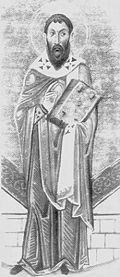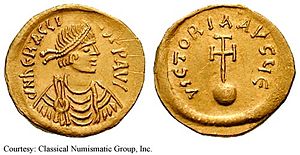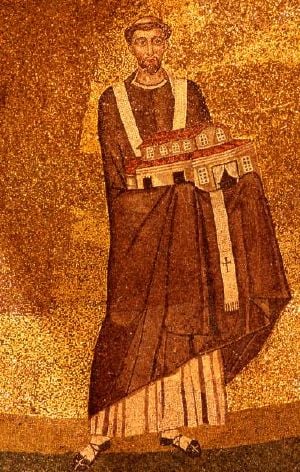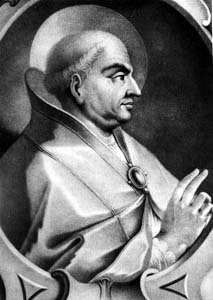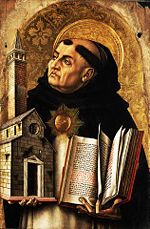Monothelitism
Monothelitism (from Greek, referring to "one will") is theological doctrine influential in the seventh century CE, teaching that Christ's human will was at all times completely one with the will of God.
An outgrowth of the Monophysite controversy of the previous century, Monothelitism holds that while Jesus Christ had two natures (both human and divine), he had only one will (divine/human), which must be distinguished from the will of God. The "orthodox" view, on the other hand, holds that Jesus had both a human will and a divine will.
Apparently as a result of the suggestion of Emperor Heraclius (610–641), the Monothelite position was first promulgated by Patriarch Sergius I of Constantinople (patriarch 610–638) and succeeded for a time in reconciling the Monophysite churches of the East and Africa with the leading orthodox congregations. Much to the embarrassment of the Catholic Church, it was seemingly endorsed by Pope Honorius I (reigned 625–638).
After Honorius' death, Monothelitism was opposed by succeeding popes, while in the East it was supported by several emperors and leading patriarchs of the church, resulting a bitter schism which witnessed the martyrdom of such orthodox figures as Pope Martin I and Saint Maximus the Confessor.
Monothelitism was finally condemned at the Third Council of Constantinople (the Sixth Ecumenical Council, 680–681), which also condemned Pope Honorius as a heretic. The leaders of the Oriental Orthodox churches and the Maronite church were also condemned as heretical, although they deny that they ever held the Monothelite view, describing their Christology as miaphysite.
Background
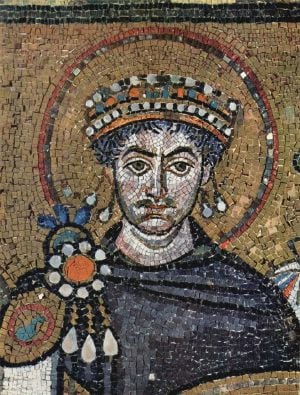
Monothelitism grew out of the christological controversies dealing with the question of whether Christ had one nature (divine/human) or two (divine and human). In these bitter and contentious debates, which often divided the eastern and western Christian churches, the Nestorians had emphasized two distinct natures in Christ, the Monophysites had insisted on one nature in which Christ's divinity and humanity were fully harmonized, and the "Orthodox" ultimately prevailed with a formula which upheld the idea of "two natures" but rejected the nation that the natures were in any way distinct from one another. The definition of Council of Chalcedon thus states that Jesus was one person with two natures and that these two natures are "without distinction or confusion."
In the short run, however, this formula proved inadequate to solve the problem, being considered far too "Nestorian" for many Monophysite churchmen. Many churches, especially in the East and Africa, remained Monophysite, and various formulas were attempted by the eastern Emperors to reconcile with the opposing factions, resulting more often than not in even more division and especially bitter feuds between Constantinople and the Roman papacy.
Monothelitism emerged as another compromise position, in which the former Monophysites might agree that Jesus had two natures if it were also affirmed that his will was completely united with that of God, while some Chalcedonian Christians might agree that Jesus' will was always united with the will of God, as long as it was affirmed that Christ also had two natures.
The terminology of the Monothelite controversy his highly technical, causing even one pope, Honorius, to stumble in this "heresy." At stake was the question as to whether Jesus was truly "human," for if his will was always that of God, how could he share in our humanity or be truly tempted by Satan, as the Bible reports he was? Moreover, if Jesus had only one (divine) will, how can one explain his agony in the Garden of Gethsemane, when he himself appears to make a distinction between his will and that of God?
Details
Though not a trained theologian, Patriarch Sergius I of Constantinople, as the bishop of the capital city of the Byzantine Empire, held authority among the Christian churches rivaled only by that of the bishop of Rome. In a letter to Pope Honorius I, Segius wrote that Emperor Heraclius came to Armenia about 622 during a military campaign, where he disputed with a Monophysite leader named Paul refuting his claims by arguing for one "nature" in Christ but admitting "one operation" in term of Christ's will. Later on, the emperor inquired of Bishop Cyrus of Phasis whether his words were correct. Cyrus was uncertain, and at the emperor's order, he wrote to Sergius in Constantinople, whom Heraclius greatly trusted, for advice. Sergius in reply sent him a letter citing several authorities, including the late Pope Vigilius, in support of "one operation" and "one will." In June, 631, Cyrus was promoted by the emperor to the important position of patriarch of Alexandria.
Practically the whole of Egypt was at this time still Monophysite. Former emperors had made efforts toward reunion, to little success. In the fifth century the compromise document known as the Henotikon of Emperor Zeno had resulted in the so-called Acacian schism between Rome and Constantinople and yet was rejected by many Monophysites, as well as the popes. In the sixth century, the Justinian I's condemnation of the Three Chapters had nearly caused a another schism between East and West without in the least placating the Monophysites.
In Alexandria, Cyrus was for the moment more successful. He obtained the acceptance by the Monophysites of a series of nine theological points, in which Christ's "one operation" of divine/human will was asserted along with the Chalcedonian "two natures" and "one composite hypostasis (person)." Through this formula, Cyrus effected the reunion of the Alexandrian church and nearly all of Egypt and northern Africa.
However, the future Saint Sophronius, a much venerated monk of Palestine soon to become patriarch of Jerusalem, who was in Alexandria at this time, strongly objected to the expression "one operation." He went to Constantinople, and urged Patriarch Sergius that the seventh of the nine "chapters" promoted by Cyrus must be withdrawn. Sergius was not willing to risk losing the African churches again by ordering this, but he did write to Cyrus that it would be well for the future to drop both the expressions: "one operation" and "two operations." He also advised referring the question to the pope. Cyrus politely responded that Sergius was, in effect, declaring the emperor to be wrong.
Honorius endorses 'one Will'
In his letter to Pope Honorius I, Sergius went so far as to admit that "one operation," though used by several Church Fathers, is a strange expression that might suggest a denial of the "unconfused union of two natures." However, he also argued that the idea of "two operations" is even equally dangerous, suggesting "two contrary wills." He concluded that it is best to confess that "from one and the same incarnate Word of God (Jesus) proceed indivisibly and inseparably both the divine and the human operations."
Honorius replied by praising Sergius for rejecting "two operations," approving his recommendations, and refraining from criticizing any of the propositions of Cyrus. In a crucial sentence, he also stated that "We acknowledge one Will of our Lord Jesus Christ."
The Ecthesis of Heraclius
Late in 638 the Ecthesis of Heraclius was issued, composed by Sergius and authorized by the emperor. Sergius himself died on December 9 of that year, a few days after having celebrated a council in which the Ecthesis was acclaimed as "truly agreeing with the Apostolic teaching" of popes Honorius and Vigilius. Cyrus of Alexandria received the news of this council with great joy.
The Ecthesis reaffirmed the doctrines of five Ecumenical Councils, including Chalcedon, but added a prohibition against speaking of either "one operation" or "two operations," at the same time affirming the "one will in Christ lest contrary wills should be held." Honorius, meanwhile, had died on October 12 and was not in a position to confirm whether this statement conformed with his view.
Papal envoys promised to submit the Echthesis to [[Pope Severinus], but the new pope was not consecrated until May, 640 and died just two months later without having offered his opinion on the Ecthesis. Pope John IV, who succeeded him in December, quickly convened a synod which condemn it formally. Emperor Heraclius, thinking the Echthesis had promulgated the view of Pope Honorius, now disowned the Echthesis in a letter to John IV and laid the blame on Sergius. When Heraclius died in February 641, the pope wrote to his successor, Constantine III, saying that the Ecthesis would doubtless now be withdrawn and apologizing for Pope Honorius, who, he said, had not meant to teach one will in Christ.
However, the new patriarch, Pyrrhus, was a supporter of the Ecthesis and the document was confirmed in a major church council at Constantinople. In Jerusalem, the orthodox champion Sophronius was succeeded by a supporter of the Ecthesis, and another Monthelite bishop now sat in the see of Antioch. In Alexandria, the city fell into the hands of the Muslims under Amru in 640. Among the great cities of the empire, only Rome thus remained "orthodox," while Constantinople, Antioch, Jerusalem, and Alexandria were Monothelite, the latter soon to become Muslim.
Constans II and the 'Type'
Constans II became the new emperor in 641, and like others before him he attempted a reconciliation between the factions based on a policy of banning either extreme, a policy doomed to failure. In May 643, the bishops of Cyprus, independent of any patriarch, held a synod against the Ecthesis, entreating Pope Theodore I, who had ascended to the throne of Saint Peter the previous year, for support, declaring themselves ready to be martyred rather than forsake the "orthodox" doctrine of "two wills." In 646 certain bishops of Africa and the adjoining islands also held councils and likewise wrote afterward to Theodore in solidarity.
The situation now deteriorated into violence. Although Emperor Constans had exiled Patriarch Pyrrhus to Africa, his successor, Paul, continued to support the Ecthesis. Pope Theodore, from Rome, pronounced a sentence of deposition against Paul, and the patriarch retaliated by destroying the Latin altar which belonged to the Roman see at Constantinople. He also punished the papal representatives in Constantinople, as well as certain laymen who supported the Roman position, together with certain laymen and priests, by imprisonment, exile, or whipping.
Paul clearly believed himself to be in accord with two previous popes, Honorius and Vigilis; and he was not unwilling to compromise. He therefore persuaded the emperor to withdraw the Ecthesis and to substitute an orthodox confession of faith together with a disciplinary measure forbidding controversial expression regarding Christ's will. No blame was to attach to any who had used used such expressions in the past, but transgression of the new law would involve deposition for bishops and clerics, excommunication and expulsion for monks, loss of office and dignity for officials, fines for richer laymen, and corporal punishment and permanent exile for the poor. Known as the Type of Constans it was enacted sometime between September 648 and September 649, and it proved to be even less successful than the Ecthesis had been.
Pope Theodore died May 5, 649 and was succeeded in July by Pope Martin I. In October, Martin held a great council at the Lateran, at which 105 bishops were present. The council admitted the good intention of the Type (apparently so as to spare the emperor while condemning Patriarch Paul), but declared the document heretical for forbidding the teaching of "two operations" and "two wills." It passed 20 canons, the eighteenth of which anathematizes Cyrus, Sergius, Pyrrhus, Paul, the Ecthesis, and the Type. Pope Honorius, who had caused so much trouble by seeming to endorse the "one will," however, escaped criticism. An encyclical letter summarizing the proceedings was sent to churches and monasteries throughout the empire in the name of Pope Martin I and the council.
The pope now commissioned to Bishop John of Philadelphia to appoint appoint orthodox bishops, priests, and deacons in the patriarchates of Antioch and Jerusalem. Martin also deposed Archbishop John of Thessalonika and declared the appointments of Macarius of Antioch and Peter of Alexandria to be null and void. Emperor Constans retaliated by having Martin kidnapped at Rome and taken as a prisoner to Constantinople. The pope still refused to accept either the Ecthesis or the Type, and he died a martyr in the Crimea in March 655. Other famous martyrs in the controversy include Maximus the Confessor (662), his disciple and fellow monk Anastasius (662), and another Anastasius who was a papal envoy (666).
Patriarch Paul of Constantinople himself was dying of natural causes, and had convinced the Emperor to spare the pope's life temporarily. At Paul's death, Pyrrhus was restored as patriarch of Constantinople. His successor, Peter, sent an ambiguous letter to Pope Eugenius, which made no mention of either one or two "operations," thus observing the prescription of the Type.
In 663 Constans came to Rome, intending to make it his residence. The new pope, Vitalian, received him with all due honor, and Constans—who had refused to confirm the elections of Martin and Eugenius—ordered the name of Vitalian to be inscribed on the diptychs of Constantinople. No mention seems to have been made of the Type and Constans soon retired to Sicily, where he was murdered in his bath in 668.
The new emperor, Constantine Pogonatus, does not seem to have enforced the Type, although it was not abolished. In 678, he summoned a general council to effect unity between the Eastern and Western churches. He wrote in this sense to Pope Donus (676-78), who, however was already dead. His successor, Agatho convened a council at Rome toward this end, and the emperor, for his part, sent the Monothelite Patriarch Theodore of Constantinople into exile, as he had become an obstacle to reunion.
The first session of the Sixth Ecumenical Council took place at Constantinople on November 7, 680 with Emperor Constantine Pogonatus presiding. Patriarch Macarius of Antioch was outspoken for Monothelitism, but with emperor now opposed to this cause, Marcarius was condemned as a heretic. George, the new patriarch of Constantinople generally upheld the Roman view. However, as Macarius had appealed to the late Pope Honorius, tis pope was likewise condemned, which was an embarrassment to the papacy. The final decree of the council condemns the Ecthesis and the Type and several heretics, including Honorius, while affirming the letters of Pope Agatho and his council.
As Agatho had died before receiving the results of the council, it fell to Pope Leo II to confirm it, and. thus the churches of the East and West were once again united.
In 711 the imperial throne was seized by Philippicus Bardanes, who had been the pupil of the Monothelite monk Abbot Stephen, an associate of Macarius of Antioch. He restored to the diptychs the "heretics" Patriarch Sergius, Pope Honorius, and the others condemned by the Sixth Ecumenical Council and privately burned its acts. He also deposed Patriarch Cyrus of Constantinople and exiled and number of person who refused to subscribe a rejection of the council. After his reign ended on June 4, 713 "orthodoxy" was restored by Anastasius II (713-15). This was, in effect, the end of Monothelitism.
Notable Figures in the Monothelite Debate
- Patriarch Sergius I of Constantinople—a supporter of the monothelite position
- Bishop Cyrus of Alexandria—one of the originators of the monothelite position
- Pope Honorius I—Condemned at Constantinople for his failure to combat Monothelitism[1]
- Pope Martin I—Martyred by Byzantine authorities for his condemnation of Monothelitism at the First Lateran Synod
- Maximus the Confessor—Martyred by Byzantine authorities for his condemnation of Monothelitism
- Pope Agatho—Condemned Monothelitsm at the Council of Constantinople
See also
- Monophysitism
- Chalcedonian
- Miaphysite
- Papal Oath (Liber Diurnus)
Notes
- ↑ The Acts of the Council state: "And with these we define that there shall be expelled from the holy Church of God and anathematized Honorius who was some time Pope of Old Rome, because of what we found written by him to Sergius, that in all respects he followed his view and confirmed his impious doctrines" (13th Session) and "To Honorius, the heretic, anathema!" (16th Session).
ReferencesISBN links support NWE through referral fees
External links
| |||||||||||||||||||||||||||||||||||||||||||||
| |||||||||||||||||||||||||||||||||||||||||
| ||||||||||||||||||||||||||||||||||||||||||
Credits
New World Encyclopedia writers and editors rewrote and completed the Wikipedia article in accordance with New World Encyclopedia standards. This article abides by terms of the Creative Commons CC-by-sa 3.0 License (CC-by-sa), which may be used and disseminated with proper attribution. Credit is due under the terms of this license that can reference both the New World Encyclopedia contributors and the selfless volunteer contributors of the Wikimedia Foundation. To cite this article click here for a list of acceptable citing formats.The history of earlier contributions by wikipedians is accessible to researchers here:
The history of this article since it was imported to New World Encyclopedia:
Note: Some restrictions may apply to use of individual images which are separately licensed.

